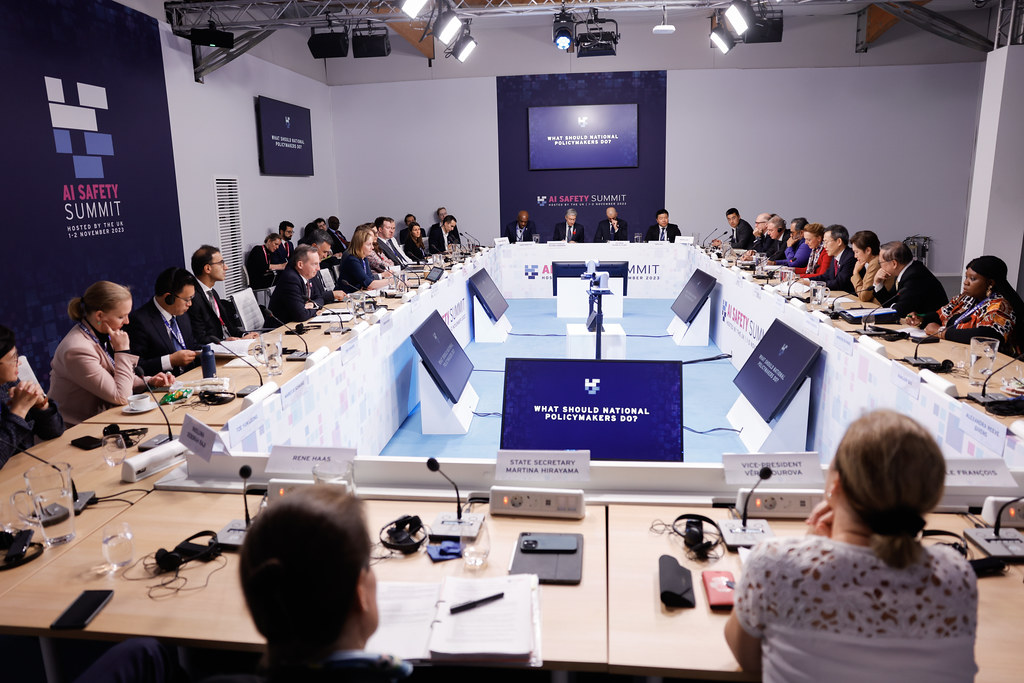SinoTech: China Takes the Trade War to a New Front, and ZTE Stays Alive
Months of trade talks have proven unsuccessful at halting the escalating U.S.-China tech trade conflict, as the U.S. finally implemented its first wave of 25 percent tariffs against $34 billion in high-tech Chinese imports on July 6.
Published by The Lawfare Institute
in Cooperation With

Months of trade talks have proven unsuccessful at halting the escalating U.S.-China tech trade conflict, as the U.S. finally implemented its first wave of 25 percent tariffs against $34 billion in high-tech Chinese imports on July 6. Those tariffs cover 818 products selected by the Office of the United States Trade Representative following its investigation under Section 301 of the Trade Act of 1974 into China’s policies relating to technology transfer and intellectual property. The list includes many goods favored under the Chinese government’s “Made in China 2025” initiative. The tariffs do not yet include a second set of 284 products that the USTR has identified as particularly important to “Made in China 2025,” and which account for an additional $16 billion in annual imports. That second list is expected to go through additional notice and comment procedures before implementation, but may be overshadowed by the Trump administration’s threatened additional tariffs on $200 billion worth of Chinese imports, including consumer goods.
The Chinese government has maintained a measured posture, promising that it would not instigate new trade restrictions, but would respond in kind against any tariffs launched by the U.S. As promised, the Chinese government immediately retaliated against the U.S. tariffs with 25 percent tariffs on $34 billion in American goods—predominantly agricultural goods, automobiles and energy products. Beijing has also prepared a second tariff list covering American products worth about $16 billion, set to be implemented in response to the second wave of U.S. tariffs.
The escalating tariffs have produced acute concern among targeted industries. American soybean farmers, for instance, immediately felt the pain of China’s retaliatory tariffs. Those farmers sell almost one-third of their total output to the Chinese market, but Chinese buyers are expected to cancel most orders if tariffs remained in place, although continued U.S. imports may be necessary to meet consumer demand. Some American soy farmers now appear worried that the trade conflict could cause “serious damages” to the industry, but the American Soy Association’s appeals to consider alternative means of reducing the trade deficit appear to have fallen on deaf ears. The soy farmers are not alone; the U.S. Chamber of Commerce and members of the president’s own party have also denounced the Trump Administration’s trade strategy, including the newly unveiled 10 percent tariffs on $200 billion of goods (which will first undergo notice and comment procedures, and are not expected to come into force for at least two months). Although many view China’s retaliatory tariffs as a strategic move to undermine Trump’s voter base by attacking red-state industries, the White House has refused to balk.
Chinese government shifts fronts of trade war to WTO and EU
As U.S. tariffs on Chinese imports have threatened to exceed total Chinese imports from the United States, limiting the Chinese government’s ability to retaliate in kind, Beijing has pushed the trade conflict further into the realm of international adjudication and diplomacy. On July 6, the Chinese Ministry of Commerce announced that it had submitted an amended complaint in the formal dispute it launched against the Trump administration’s Section 301 tariffs in April of this year. The amendment does little more than restate the claims of the Commerce Ministry’s initial complaint, which alleges that the Section 301 tariffs violate non-discrimination principles and the United States’ scheduled tariff commitments under the General Agreement on Tariffs and Trade, or GATT, as well as provisions of the WTO’s Dispute Settlement Understanding requiring member-states to resolve controversies through the WTO.
The Commerce Ministry had submitted its original complaint less than two weeks after the United States lodged its own WTO complaint against China’s intellectual property protections as part of its opening salvo against China’s tech trade policies. The United States’ complaint has not seen any activity since early April, when the EU, Japan, Taiwan and other American allies joined the parties’ consultations. Since both the American and Chinese complaints have now passed the mandatory 60-day consultation period, both countries are now entitled to request the formation of a panel to resolve the dispute. That neither party has yet done so may indicate that the two countries are holding out hope for progress in further bilateral negotiations.
The Chinese government has also appealed to America’s historic allies in the European Union. On Monday, Chinese Prime Minister Li Keqiang and German Chancellor Angela Merkel pledged to uphold the WTO system as they signed commercial deals worth $23.5 billion in Berlin. That meeting followed an appeal to Eastern European countries during Li’s visit to the 16+1 conference in Bulgaria week. But any China-EU alliance will rest on shaky foundations for as long as major European powers remain skeptical of China’s technology-related trade and investment policies. The EU launched its own complaint against China’s policies on June 1, though it also submitted a complaint against the United States’ steel and aluminum tariffs on the same day. The Chinese government has reportedly asked the European Union to enter a joint statement against the Trump administration’s trade policies later this month, but is facing an uphill battle.
ZTE stays alive, driving White House and Congress towards clash
Embattled Chinese telecom ZTE continues to limp along as the Trump administration and Congress head towards a confrontation on the company’s future. The U.S. Department of Commerce imposed a denial order prohibiting ZTE from purchasing American components in April, but after President Xi Jinping struck a deal with the White House in June, that order was replaced by a new settlement requiring ZTE to pay a $1 billion penalty, place an additional $400 million in escrow, replace its senior leadership, and bring on a U.S.-selected team of compliance officers. ZTE’s deal frustrated some on Capitol Hill who believed that the company had been let off easy, and the Senate added an amendment to the fiscal 2019 National Defense Authorization Act (NDAA) (amendment at Section 6702) that would limit the authority of federal officials to alter trade sanctions against Chinese telecom companies, and, if passed, would retroactively reverse any deal with ZTE.
On July 2, after ZTE replaced its board, the Commerce Department reportedly granted the company a one-month reprieve to resume trade with American companies and ensure complete compliance. ZTE officials reportedly met with the Commerce Department’s Bureau of Industry and Security earlier this week to iron out a final agreement. But the NDAA has continued to work its way through Congress, setting up a potential showdown between the executive branch and the Senate. The Senate voted yesterday to move the bill to conference with the House, which is expected to begin today. Negotiations have not proven fruitful, although House Republicans are believed to be more sympathetic to President Trump’s position than those in the Senate. A White House policy statement warned that the administration “strongly objects” to the ZTE provision in the NDAA, but did not explicitly threaten a veto.
In Other News
- The National Telecommunications and Information Administration (NTIA), a division of the Commerce Department, recommended that the FCC block Chinese telecom China Mobile from entering the U.S. market last week. The NTIA’s report cited national security concerns, arguing that China Mobile, “as a prominent Chinese state-owned enterprise, cannot be expected to act against the interest of the Chinese government on any sensitive matter.” The FCC has not yet made a ruling on China Mobile’s application to operate in the U.S., which has been pending since 2011.
- A Chinese court issued an injunction order in a patent infringement case last week preventing Micron Technology, America’s largest memory-chip maker, from selling some products in China. Micron promised that it would challenge the court’s decision. It is not the first time Micron has been thrust into the trade war spotlight: as reported by New York Times last month, Micron filed suit against a Chinese and a Taiwanese chipmaker in the Northern District of California last year, alleging that those companies had intentionally stolen its intellectual property to boost China’s domestic chip industry. Those same two companies then brought the patent infringement suit that has now produced an injunction, leading some to frame Micron’s struggles as a microcosm of the larger U.S.-China “tech cold war.”
- The Chinese government announced loosened restrictions on foreign investment in several industries late last month, fulfilling promises made by President Xi at the Boao Forum in April. Some experts were not impressed, arguing that the measures do not go far enough or had already been promised in earlier policy announcements.
- Chinese scientists broke a world record in quantum computing by achieving quantum entanglement with 18 qubits, surpassing the previous record of 10. The study was published in the U.S. journal Physical Review Letters and was said to create “a new and versatile platform” for quantum information processing.
Commentary & Analysis
Elsewhere on Lawfare, Chris Meserole examines the use of developing technologies to counter terrorism, including the Chinese government’s adoption of facial recognition in its crackdown in the Xinjiang Uighur autonomous region. In this week’s Cyberlaw Podcast, Stewart Baker and guests discuss the Trump administration’s decisions to extend a lifeline to ZTE but turn down China Mobile (at 2:30). Last week, the podcast addressed the administration’s positions on the NDAA (at 11:00), and the episode before mentioned potential new restrictions on Chinese investment (at 21:00) and the increasing stealth of Chinese hackers (at 22:50). At Just Security, Steven Feldstein and David Sullivan recommend stronger protections for cyber attacks against civilians, citing the Chinese government’s actions in Xinjiang.
At the Council on Foreign Relations, Brad Setser provides an excellent summary of the core legal grievances underlying the Trump administration’s tariffs against China, and Ashley Feng and Stewart Patrick describe China’s attempts to export its model of internet censorship through the “digital silk road.” David Dollar outlines the likely effects of those tariffs on the American and Chinese economies for Brookings. The Center for Strategic and International Studies’ team of trade experts analyzes the Trump administration’s decision to restrict Chinese investment in the U.S. through CFIUS reform. A new report from the Atlantic Council discusses the global race to develop cutting-edge technologies, focusing on competition between the U.S. and China.
In Politico, Ben White, Nancy Cook, Andrew Restuccia, and Doug Palmer pull back the curtain on the Trump Administration’s internal deliberations. In the New York Times, Paul Krugman forecasts hardship for American manufacturers from the new tariffs. At Vox, 11 experts give their takes on how the trade war may play out. Heather Somerville examines the Chinese government’s links to Silicon Valley venture capital firms for Reuters.






